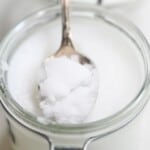How to Make Extra Virgin Coconut Oil
How to make virgin coconut oil at home - this is an unrefined cold-pressed coconut oil made from just one ingredient, following a simple tutorial.
Servings: 24 Tablespoons
Ingredients
- 8 mature coconuts
This yields about 1.5 cups of oil
Instructions
Prepare coconut cream
- Make coconut cream, using one of these two methods - you can use a food processor or a juicer.While a food processor method is more accessible to most, the juicer method will be faster and yield better results.
- Once the coconut cream is ready, pour it into your designated container.
Ferment the coconut cream to produce oil
- You need to "ferment" the cream to get rid of excess water and separate the curd from the oil. Pour the coconut cream into a bowl or jar, cover it, and keep it in a warm spot for 1-2 days. You can also wrap it with a big towel or a blanket - we are looking for a slightly warm environment (95-105ºF/35-40ºC) that will help with fermenting the coconut for the oil to separate.You could keep it in your microwave or a switched-off oven to keep it warm.
- After a while, curds and oil will become separated. The oil will be on top, the coconut curds will be in the middle, and at the bottom there will be mirky water (refer to the photos in the blog post).You can also chill it to further separate the layers, before filtering the oil.
Remove/Filter the cold-pressed coconut oil
- Spoon out the oil - though this requires some patience it should be easy. Make sure to scoop only the oil and none of the curd. You can pour the oil directly into a clean/sterilized airtight container.Alternatively, you can also filter the oil through a sieve/nut milk bag/coffee filter. You can place the curds directly into the filter and the oil will drip out into your container.
Notes
You can also make homemade cold-pressed coconut oil by beginning with homemade coconut milk. You can do this by blending the grated coconut/ coconut meat 1:1 with water and then squeezing out all the milk through a nut milk bag. However, as the aim is to get rid of the water content, I prefer to start with coconut cream.
If you live in a very warm, humid climate then the coconut may spoil while fermenting and become sour. If it smells sour then the fermentation has been unsuccessful and the coconut shouldn't be consumed.
To store: Homemade coconut oil is shelf-stable and can be stored at room temperature. It should last a few months when sealed in an airtight jar.
If you notice the coconut oil yellowing or starting to look almost "curdled", often with a bad smell, then it has turned rancid. It can also grow mold - which will look like little green or brown dots - so watch out for that. If you find any of these signs then the whole jar is no longer okay to use.
Check the blog post for how to use virgin coconut oil!
Nutrition
Serving: 1Tbsp | Calories: 53kcal | Carbohydrates: 2g | Protein: 1g | Fat: 5g | Saturated Fat: 4g | Sodium: 3mg | Potassium: 53mg | Fiber: 1g | Sugar: 1g | Vitamin C: 1mg | Calcium: 2mg | Iron: 1mg
